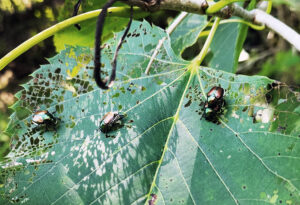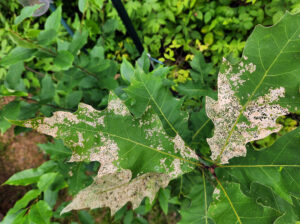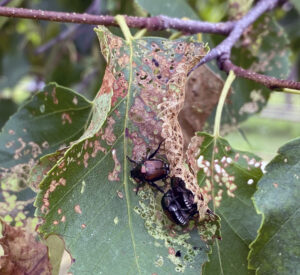By Linda Williams, DNR Forest Health Specialist, Woodruff
Linda.Williams@wisconsin.gov or 920-360-0665

A closeup photo of Japanese beetles defoliating basswood leaves. The invasive pest is becoming more prevalent in northern Wisconsin. / Photo Credit: Linda Williams, Wisconsin DNR
The Japanese beetle (Popillia japonica) is an invasive insect that feeds on many plant species. The pests “skeletonize” leaves by eating the material between the veins.
Adult Japanese beetles feed on the flowers and leaves of more than 300 plant species, including trees, shrubs and herbaceous plants. Forest trees can be defoliated, with open-grown or edge trees suffering the highest defoliation rates.

A young oak tree shows defoliation from Japanese beetle. The insect is becoming more prevalent in northern Wisconsin counties. / Photo Credit: Linda Williams, Wisconsin DNR
The insects’ favorite trees are birch, mountain ash and basswood/linden, but this year, they have also been observed feeding on the leaves of young oaks.
Adults emerge in southern Wisconsin in early July and in northern regions shortly thereafter. In much of southern Wisconsin, the beetles have been present for quite a few years, and the population has stabilized at a level that is expected to continue each year. In the north, Japanese beetle populations are still building up – for the first time in some areas – and are expected to continue to build and spread.
Some people mistake multicolored Asian lady beetles for Japanese beetles, but they are two distinctly different species.
While these beetles typically don’t kill trees, their defoliation may make trees more vulnerable to other stressors. For birch trees that are defoliated, twolined chestnut borer may attack these stressed trees, killing the top of the tree or even the entire tree.
Biological control can help to control beetles in the forest. The Winsome fly, which has been expanding its range into Wisconsin, lays its eggs on adult Japanese beetles. Their eggs look like small white dots near the head of the beetle. When the eggs hatch, the fly larvae bore into the Japanese beetle and feed within the beetle, eventually killing the Japanese beetle. If you see fly eggs attached to Japanese beetles and can report them in iNaturalist please take a moment to do so. You can see some great pictures of Winsome fly in iNaturalist.
Visit the University of Wisconsin-Madison Extension’s Japanese beetle webpage for information on control measures for adults and grubs. If you have questions or concerns about Japanese beetles on your ornamental trees and yard trees, visit Extension’s Ask A Gardener page to use a form to submit your question.

A branch of a birch tree showing significant defoliation from Japanese beetles. / Photo Credit: Linda Williams, Wisconsin DNR
